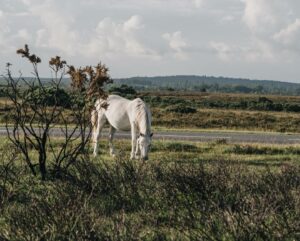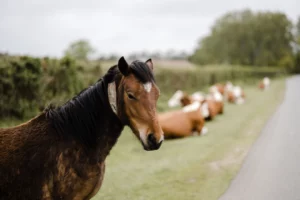The wildlife, ponies, cattle, donkeys and pigs are a huge part of life here in the New Forest, and these beautiful creatures attract visitors from all over the world to see them out in the open Forest and the towns and villages. The ponies are semi-wild but are actually owned by the commoners (people who have “rights of common of pasture” over the Forest lands) who pay an annual grazing fee known as the ‘marking fee’.
As all the animals depastured on the Forest are owned by commoners, it is their responsibility to ensure that their ponies are in good health. However, five ‘agisters’ are employed by the Verderers to watch over the forest stock and ensure that their owners meet the requirements of the Verderers regarding stock welfare. They attend road accidents and other incidents involving Commoners’ animals. Each agister has responsibility for a specific forest area.
Agisters organise the construction and ongoing maintenance of stock pounds within their area, they arrange and manage the rounding up of ponies – called drifts.
Drifts are organised in the autumn to round up and check on the health and well-being of all the ponies. Over 30 drifts happen in the Forest each year with a small area covered at a time. This helps the Commoners, the owners of the ponies, to be able to check the animals brought into their location and also to help each other.
The Agisters work with the Commoners who attend to ensure as many as possible are ’rounded up’. This can be an incredibly difficult task as the area in which the ponies roam is huge. The main aim is to gather the mares with foals. Each pony is checked, wormed, and has its tail clipped to show they have been in, and which Agister has checked them. Each Agister has its unique cut so if the ponies are rounded up again they’ll know according to the cut of the tail where and when they were previously rounded up. Foals are either branded and ‘turned back out’ or taken off from their mother to be weaned. Every Commoner has an individual brand.
Ponies living full-time on the New Forest are almost all mares, although there are also a few geldings. For much of the year the ponies live in small groups, usually consisting of an older mare, her daughters, and their foals, all keeping to a discrete area of the Forest called a “haunt.” Under New Forest regulations, mares and geldings may be of any breed. Although the ponies are predominantly New Foresters, other breeds such as Shetlands and their crossbred descendants may be found in some areas.

Stallions must be registered New Foresters and are not allowed to run free all year round in the Forest. They normally are turned out only for a limited period in the spring and summer, when they gather several groups of mares and youngstock into larger herds and defend them against other stallions. A small number (usually fewer than 50) are turned out, generally between May and August. This ensures that foals are born neither too early (before the spring grass comes through), nor too late (as the colder weather is setting in and the grazing and browsing on the Forest are dying back) in the following year.
The open nature of the New Forest means that ponies can wander onto roads. The ponies actually have the right of way over vehicles, and many wear reflective collars to reduce traffic fatalities. Still, despite this, many ponies, along with commoners’ cattle, pigs, and donkeys are killed or injured in road traffic accidents every year. Human interaction with ponies is also a problem; well-meaning but misguided visitors to the forest frequently feed them, which can create dietary problems and sickness (e.g. colic) and cause the ponies to adopt an aggressive attitude to obtain human food.

New Forest ponies are raced in an annual point-to-point meeting in the Forest, usually on Boxing Day, finishing at a different place each year. The races do not have a fixed course, but instead are run across the open Forest, so competitors choose their routes around obstructions such as enclosures (forestry plantations), fenced paddocks, and bogs. Riders with a detailed knowledge of the Forest are thus at an advantage. The location of the meeting place is given to competitors on the previous evening, and the starting point of the race is revealed once riders have arrived at the meeting point.

